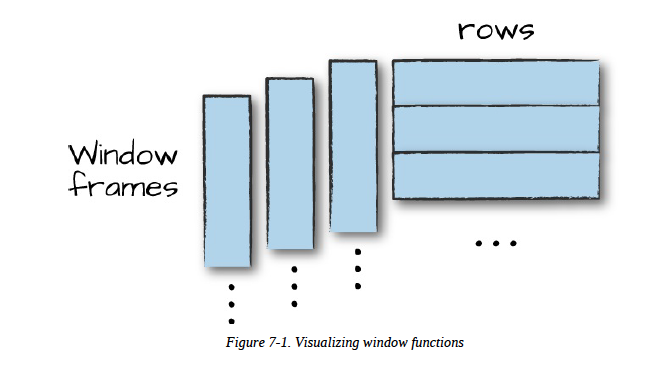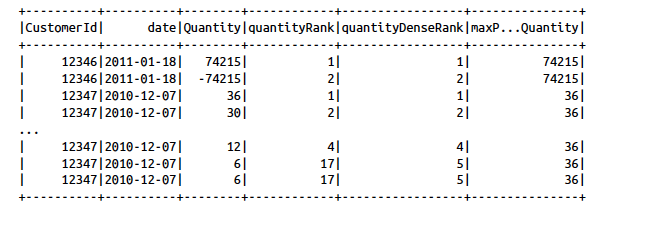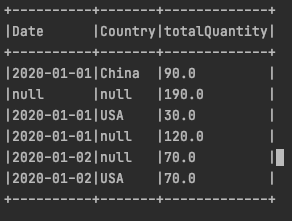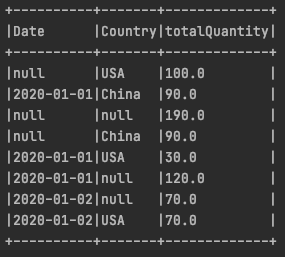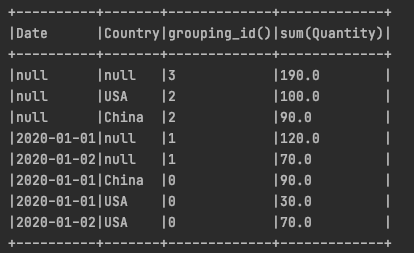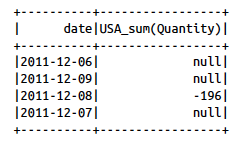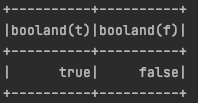前言 本文为阅读”Spark The Definitive Guide”Chapter 7 所做的归纳和整理,部分代码来自于书中,部分为自己在本机试验所得
Definition of Aggregation Aggregation is the act of collecting something together.
Brief Overview 聚合的类型主要有以下几种
针对整个数据集(Dataframe)
分组聚合
窗口聚合
Grouping Sets
rollup (Hierarchically)
cube (所有可能的组合)
返回的结果: RelationalGroupedDataset
1 2 3 4 5 6 7 val df = spark.read.format("csv" ) .option("header" , "true" ) .option("inferSchema" , "true" ) .load("/data/retail-data/all/*.csv" ) .coalesce(5 ) df.cache() df.createOrReplaceTempView("dfTable" )
Aggregation Functions 聚合函数大部分被定义在 or.apache.spark.sql.functions
count 1 2 import org.apache.spark.sql.functions.countdf.select(count("StockCode" )).show()
countDistinct 1 2 import org.apache.spark.sql.functions.countDistinctdf.select(countDistinct("StockCode" )).show()
approx_count_distinct 1 2 import org.apache.spark.sql.functions.approx_count_distinctdf.select(approx_count_distinct("StockCode" , 0.1 )).show()
first and last 1 2 import org.apache.spark.sql.functions.{first, last}df.select(first("StockCode" ), last("StockCode" )).show()
min and max 1 2 import org.apache.spark.sql.functions.{min, max}df.select(min("Quantity" ), max("Quantity" )).show()
sum 1 2 import org.apache.spark.sql.functions.sumdf.select(sum("Quantity" )).show()
sumDistinct 1 2 import org.apache.spark.sql.functions.sumDistinctdf.select(sumDistinct("Quantity" )).show()
avg 1 2 3 4 5 6 7 8 9 10 11 import org.apache.spark.sql.functions.{sum, count, avg, expr}df.select( count("Quantity" ).alias("total_transactions" ), sum("Quantity" ).alias("total_purchases" ), avg("Quantity" ).alias("avg_purchases" ), expr("mean(Quantity)" ).alias("mean_purchases" )) .selectExpr( "total_purchases/total_transactions" , "avg_purchases" , "mean_purchases" ).show()
variance and standard deviation 1 2 3 4 import org.apache.spark.sql.functions.{var_pop, stddev_pop}import org.apache.spark.sql.functions.{var_samp, stddev_samp}df.select(var_pop("Quantity" ), var_samp("Quantity" ), stddev_pop("Quantity" ), stddev_samp("Quantity" )).show()
skewness and kurtosis 1 2 import org.apache.spark.sql.functions.{skewness, kurtosis}df.select(skewness("Quantity" ), kurtosis("Quantity" )).show()
covariance and correlation 1 2 3 import org.apache.spark.sql.functions.{corr, covar_pop, covar_samp}df.select(corr("InvoiceNo" , "Quantity" ), covar_samp("InvoiceNo" , "Quantity" ), covar_pop("InvoiceNo" , "Quantity" )).show()
aggregating to complex types 1 2 import org.apache.spark.sql.functions.{collect_set, collect_list}df.agg(collect_set("Country" ), collect_list("Country" )).show()
Grouping 分组聚合,输入多行,输出一行
Grouping With Expressions 1 2 3 df.groupBy("InvoiceNo" ).agg( count("Quantity" ).alias("quan" ), expr("count(Quantity)" )).show()
Grouping With Maps 1 df.groupBy("InvoiceNo" ).agg("Quantity" ->"avg" , "Quantity" ->"stddev_pop" ).show()
Window Functions 对输入的每一行在一个分组的窗口范围内做计算,最后为每一行输出一个结果
执行一个窗口函数需要两个要素
定义一个窗口
定义一个窗口函数 , 输入: 窗口内的所有行, 输出:一行,目前Spark支持三种窗口函数
aggregate function
ranking function
analytic function
如何定义一个窗口 一个窗口的定义需要三个要件
分组定义,即partition by 的条件,窗口只在指定的分组内生效
分组内排序条件,即order by的条件,指定了在一个分组内的每一行如何排列
Window Frame的定义,即rowsBetween, 指定了哪些行可以落在当前行的窗口内
为了更好的说明,举个例子
1 2 3 4 5 6 import org.apache.spark.sql.expressions.Window import org.apache.spark.sql.functions.colval windowSpec = Window .partitionBy("CustomerId" , "date" ) .orderBy(col("Quantity" ).desc) .rowsBetween(Window .unboundedPreceding, Window .currentRow)
上述代码定义了一个窗口,首先Window.partitionBy("CustomerId", "date") 指定了当前窗口的分组为相同CustomerId, 相同日期的行,接着orderBy指定了在分组内按照Quantity来排序,最后,rowsBetween 定义了对于每一行来说窗口作用的范围,在上述例子中代表当前行前的所有行到当前行,当然也可以用数字,例如rowsBetween(-1,0)代表前一行到当前行
定义一个窗口函数 目前Spark支持的窗口函数主要有三种
aggregate function
ranking function
analytic function
分别举例说明
aggregate function 1 2 import org.apache.spark.sql.functions.maxval maxPurchaseQuantity = max(col("Quantity" )).over(windowSpec)
上述代码返回了窗口内的最大Quantity值
ranking function 1 2 3 import org.apache.spark.sql.functions.{dense_rank, rank}val purchaseDenseRank = dense_rank().over(windowSpec)val purchaseRank = rank().over(windowSpec)
dense_rank() 返回去重后的rank
rank() 返回真实排名,如果同一个排名有多个相同的值,后续的rank依次累加
完整的例子 Scala 1 2 3 4 5 6 7 8 9 10 11 12 13 14 15 16 17 18 19 20 21 22 23 24 25 26 27 28 29 30 31 32 import org.apache.spark.sql.functions.{col, to_date}val dfWithDate = df.withColumn("date" , to_date(col("InvoiceDate" ), "MM/d/yyyy H:mm" )) dfWithDate.createOrReplaceTempView("dfWithDate" ) import org.apache.spark.sql.expressions.Window import org.apache.spark.sql.functions.colval windowSpec = Window .partitionBy("CustomerId" , "date" ) .orderBy(col("Quantity" ).desc) .rowsBetween(Window .unboundedPreceding, Window .currentRow) import org.apache.spark.sql.functions.maxval maxPurchaseQuantity = max(col("Quantity" )).over(windowSpec)import org.apache.spark.sql.functions.{dense_rank, rank}val purchaseDenseRank = dense_rank().over(windowSpec)val purchaseRank = rank().over(windowSpec)import org.apache.spark.sql.functions.coldfWithDate.where("CustomerId IS NOT NULL" ).orderBy("CustomerId" ) .select( col("CustomerId" ), col("date" ), col("Quantity" ), purchaseRank.alias("quantityRank" ), purchaseDenseRank.alias("quantityDenseRank" ), maxPurchaseQuantity.alias("maxPurchaseQuantity" )).show()
SQL 1 2 3 4 5 6 7 8 9 10 11 12 13 14 15 16 17 18 19 SELECT CustomerId, date , Quantity, rank (Quantity) OVER (PARTITION BY CustomerId, date ORDER BY Quantity DESC NULLS LAST ROWS BETWEEN UNBOUNDED PRECEDING AND CURRENT ROW ) as rank , dense_rank (Quantity) OVER (PARTITION BY CustomerId, date ORDER BY Quantity DESC NULLS LAST ROWS BETWEEN UNBOUNDED PRECEDING AND CURRENT ROW ) as dRank, max (Quantity) OVER (PARTITION BY CustomerId, date ORDER BY Quantity DESC NULLS LAST ROWS BETWEEN UNBOUNDED PRECEDING AND CURRENT ROW ) as maxPurchase FROM dfWithDate WHERE CustomerId IS NOT NULL ORDER BY CustomerId
Grouping Sets grouping sets可以理解为按照一个或多个维度分组并统计,grouping sets只作用于SQL
例如,下面两段SQL在结果上是等效的
1 2 3 SELECT CustomerId, stockCode, sum (Quantity) FROM dfNoNullGROUP BY customerId, stockCodeORDER BY CustomerId DESC , stockCode DESC
1 2 3 SELECT CustomerId, stockCode, sum (Quantity) FROM dfNoNullGROUP BY customerId, stockCode GROUPING SETS ((customerId, stockCode))ORDER BY CustomerId DESC , stockCode DESC
如果我们想要得到对整个结果集以及根据 (CustomerId, stockCode)维度的统计,则需要用到grouping sets
1 2 3 SELECT CustomerId, stockCode, sum (Quantity) FROM dfNoNullGROUP BY customerId, stockCode GROUPING SETS ((customerId, stockCode),())ORDER BY CustomerId DESC , stockCode DESC
同时需要注意的是,grouping sets的数据源必须没有null,否则将会和结果集的null有冲突
Rollups Rollups 将 group中的每个元素按照层级进行group by,例如
1 2 3 4 5 6 7 8 9 val rolledUpDf = Seq ( ("2020-01-01" , "USA" , "30" ), ("2020-01-02" , "USA" , "70" ), ("2020-01-01" ,"China" ,"90" )) .toDF("Date" ,"Country" ,"Quantity" ) .rollup("Date" ,"Country" ) .agg(sum("Quantity" )) .selectExpr("Date" , "Country" ,"`sum(Quantity)` as totalQuantity" ) rolledUpDf.show(false )
上述代码将按照三个level进行聚合
()
group by (Date)
group by (Date, Country)
Cube 按照所有可能的组合进行group by
1 2 3 4 5 6 7 8 9 val cubedDF = Seq ( ("2020-01-01" , "USA" , "30" ), ("2020-01-02" , "USA" , "70" ), ("2020-01-01" ,"China" ,"90" )) .toDF("Date" ,"Country" ,"Quantity" ) .cube("Date" ,"Country" ) .agg(sum("Quantity" )) .selectExpr("Date" , "Country" ,"`sum(Quantity)` as totalQuantity" ) cubedDF.show(false )
为不同的grouping打上编号
1 2 3 4 5 6 7 8 9 10 11 import org.apache.spark.sql.functions.{grouping_id, sum, expr}val cubedDF = Seq ( ("2020-01-01" , "USA" , "30" ), ("2020-01-02" , "USA" , "70" ), ("2020-01-01" ,"China" ,"90" )) .toDF("Date" ,"Country" ,"Quantity" ) .cube("Date" ,"Country" ) .agg(grouping_id(),sum("Quantity" )) .orderBy(expr("grouping_id()" ).desc) cubedDF.show(false )
Pivot 行转列
1 2 val pivoted = dfWithDate.groupBy("date" ).pivot("Country" ).sum()pivoted.where("date > '2011-12-05'" ).select("date" ,"`USA_sum(Quantity)`" ).show()
User-Defined Aggregation Functions 用户自定义聚合函数(UDAF)的几个要件
inputSchema
bufferSchema
deterministic
initialize
update
merge
evaluate
例子:实现一个聚合函数,输入多行,返回多行是否都为true
1 2 3 4 5 6 7 8 9 10 11 12 13 14 15 16 17 18 19 20 21 22 23 24 25 import org.apache.spark.sql.expressions.MutableAggregationBuffer import org.apache.spark.sql.expressions.UserDefinedAggregateFunction import org.apache.spark.sql.Row import org.apache.spark.sql.types._class BoolAnd extends UserDefinedAggregateFunction def inputSchema StructType = StructType (StructField ("value" , BooleanType ) :: Nil ) def bufferSchema StructType = StructType ( StructField ("result" , BooleanType ) :: Nil ) def dataType DataType = BooleanType def deterministic Boolean = true def initialize MutableAggregationBuffer ): Unit = { buffer(0 ) = true } def update MutableAggregationBuffer , input: Row ): Unit = { buffer(0 ) = buffer.getAs[Boolean ](0 ) && input.getAs[Boolean ](0 ) } def merge MutableAggregationBuffer , buffer2: Row ): Unit = { buffer1(0 ) = buffer1.getAs[Boolean ](0 ) && buffer2.getAs[Boolean ](0 ) } def evaluate Row ): Any = { buffer(0 ) } }
1 2 3 4 5 6 7 8 9 10 11 12 13 object BoolAnd def main Array [String ]):Unit = { val ba = new BoolAnd val spark = SparkSession .builder().master("local" ).appName("yifan_spark_test2" ) .getOrCreate() spark.udf.register("booland" , ba) spark.range(1 ) .selectExpr("explode(array(TRUE, TRUE, TRUE)) as t" ) .selectExpr("explode(array(TRUE, FALSE, TRUE)) as f" , "t" ) .select(ba(col("t" )), expr("booland(f)" )) .show() } }
Q&A Spark SQL 在执行聚合时(groupBy)底层调用了哪些函数?(TODO)

